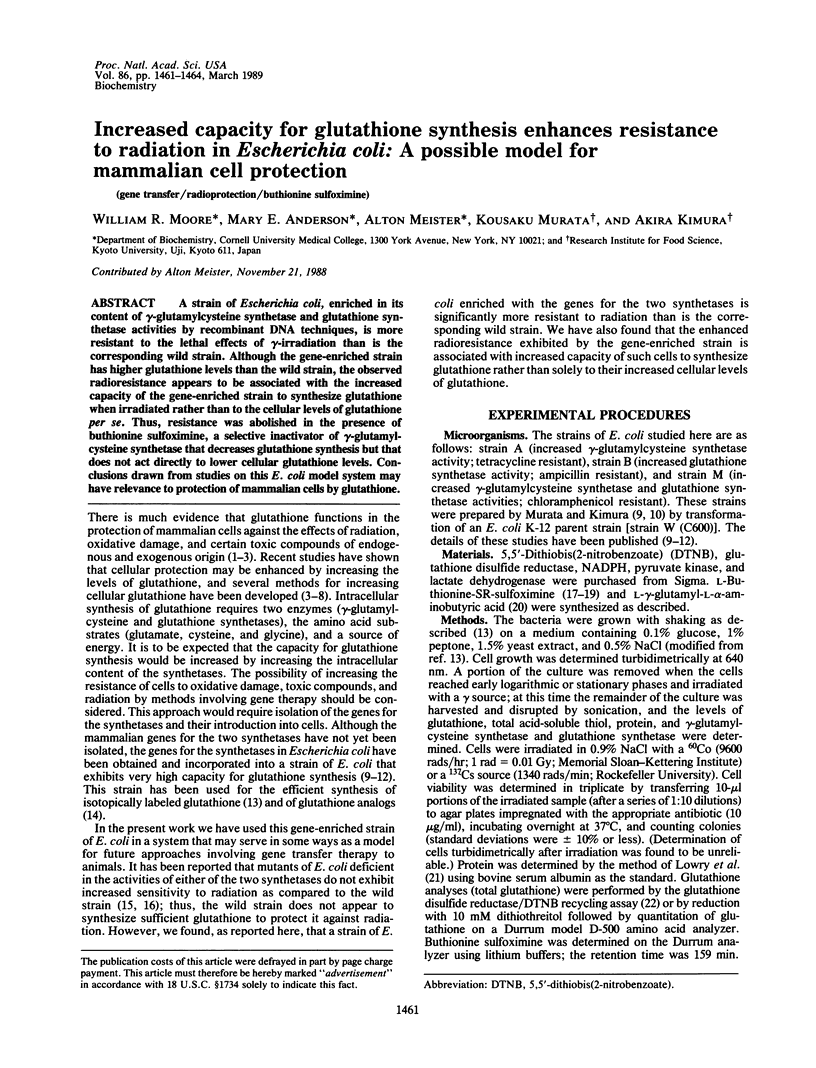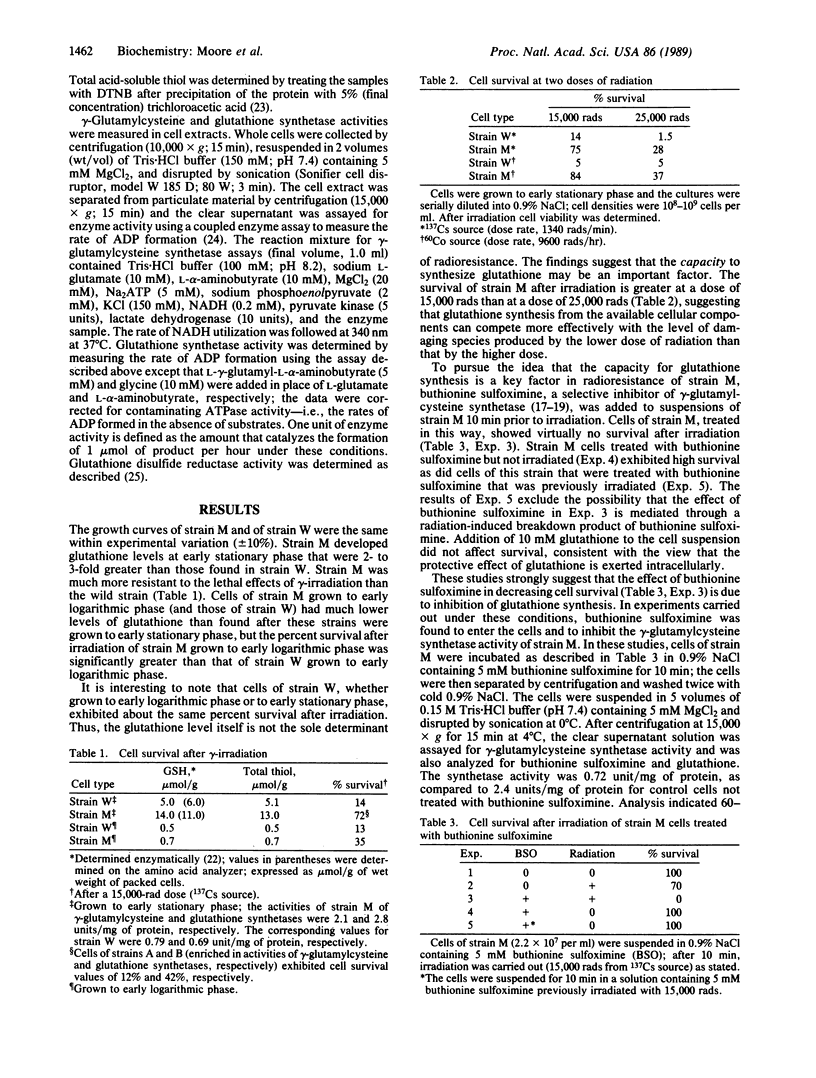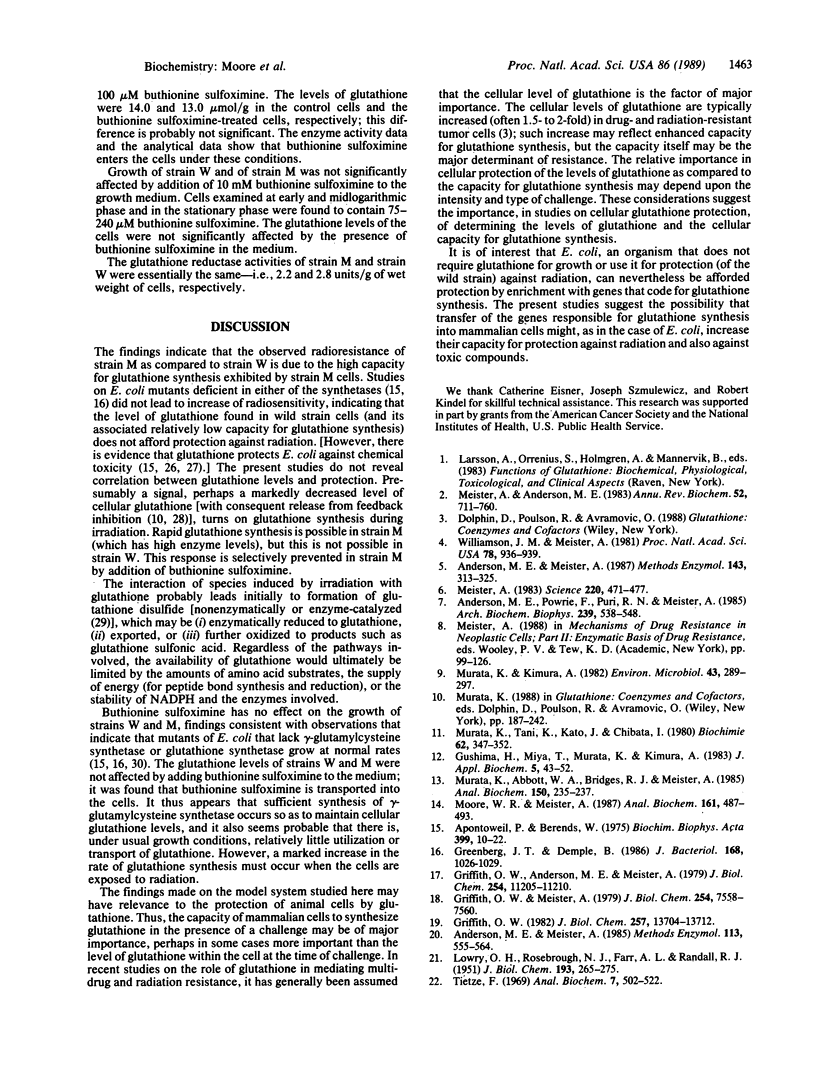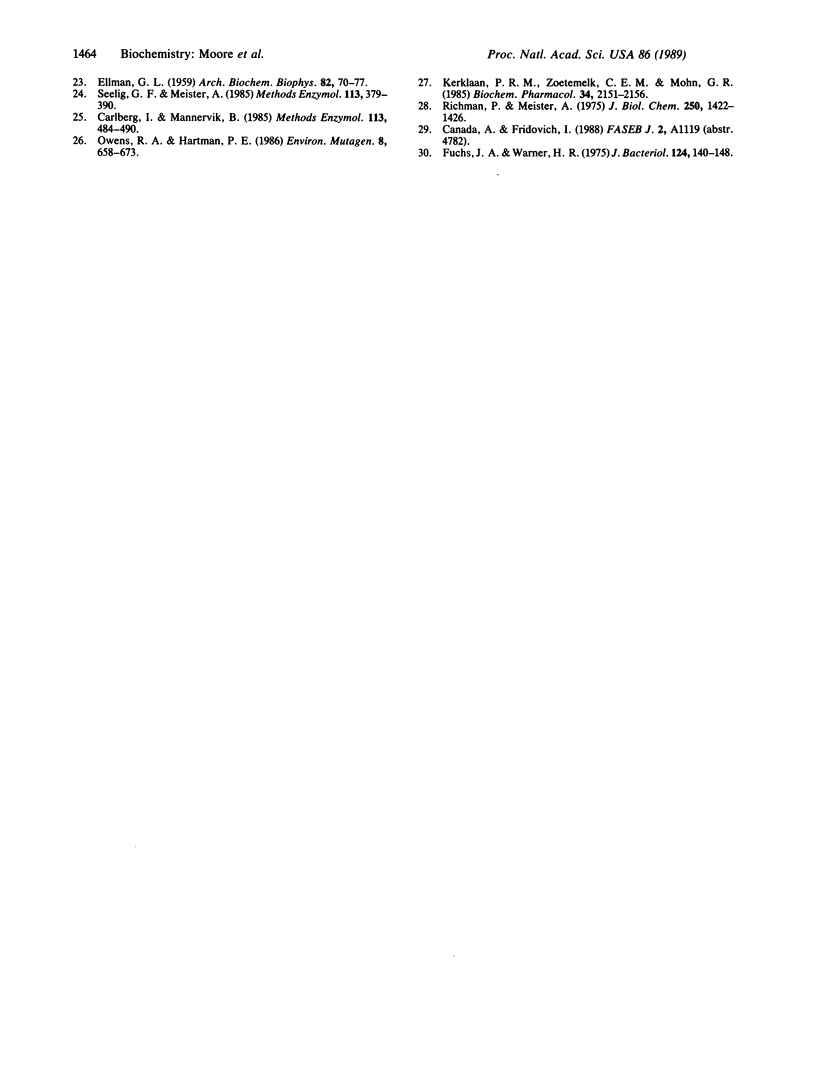Abstract
A strain of Escherichia coli, enriched in its content of gamma-glutamylcysteine synthetase and glutathione synthetase activities by recombinant DNA techniques, is more resistant to the lethal effects of gamma-irradiation than is the corresponding wild strain. Although the gene-enriched strain has higher glutathione levels than the wild strain, the observed radioresistance appears to be associated with the increased capacity of the gene-enriched strain to synthesize glutathione when irradiated rather than to the cellular levels of glutathione per se. Thus, resistance was abolished in the presence of buthionine sulfoximine, a selective inactivator of gamma-glutamylcysteine synthetase that decreases glutathione synthesis but that does not act directly to lower cellular glutathione levels. Conclusions drawn from studies on this E. coli model system may have relevance to protection of mammalian cells by glutathione.
Full text
PDF



Selected References
These references are in PubMed. This may not be the complete list of references from this article.
- Anderson M. E., Meister A. Intracellular delivery of cysteine. Methods Enzymol. 1987;143:313–325. doi: 10.1016/0076-6879(87)43059-0. [DOI] [PubMed] [Google Scholar]
- Anderson M. E., Meister A. Preparation of gamma-glutamyl amino acids by chemical and enzymatic methods. Methods Enzymol. 1985;113:555–564. doi: 10.1016/s0076-6879(85)13074-0. [DOI] [PubMed] [Google Scholar]
- Anderson M. E., Powrie F., Puri R. N., Meister A. Glutathione monoethyl ester: preparation, uptake by tissues, and conversion to glutathione. Arch Biochem Biophys. 1985 Jun;239(2):538–548. doi: 10.1016/0003-9861(85)90723-4. [DOI] [PubMed] [Google Scholar]
- Apontoweil P., Berends W. Isolation and initial characterization of glutathione-deficient mutants of Escherichia coli K 12. Biochim Biophys Acta. 1975 Jul 14;399(1):10–22. doi: 10.1016/0304-4165(75)90206-8. [DOI] [PubMed] [Google Scholar]
- Carlberg I., Mannervik B. Glutathione reductase. Methods Enzymol. 1985;113:484–490. doi: 10.1016/s0076-6879(85)13062-4. [DOI] [PubMed] [Google Scholar]
- ELLMAN G. L. Tissue sulfhydryl groups. Arch Biochem Biophys. 1959 May;82(1):70–77. doi: 10.1016/0003-9861(59)90090-6. [DOI] [PubMed] [Google Scholar]
- Fuchs J. A., Warner H. R. Isolation of an Escherichia coli mutant deficient in glutathione synthesis. J Bacteriol. 1975 Oct;124(1):140–148. doi: 10.1128/jb.124.1.140-148.1975. [DOI] [PMC free article] [PubMed] [Google Scholar]
- Greenberg J. T., Demple B. Glutathione in Escherichia coli is dispensable for resistance to H2O2 and gamma radiation. J Bacteriol. 1986 Nov;168(2):1026–1029. doi: 10.1128/jb.168.2.1026-1029.1986. [DOI] [PMC free article] [PubMed] [Google Scholar]
- Griffith O. W. Mechanism of action, metabolism, and toxicity of buthionine sulfoximine and its higher homologs, potent inhibitors of glutathione synthesis. J Biol Chem. 1982 Nov 25;257(22):13704–13712. [PubMed] [Google Scholar]
- Griffith O. W., Meister A. Potent and specific inhibition of glutathione synthesis by buthionine sulfoximine (S-n-butyl homocysteine sulfoximine). J Biol Chem. 1979 Aug 25;254(16):7558–7560. [PubMed] [Google Scholar]
- Gushima H., Miya T., Murata K., Kimura A. Construction of glutathione-producing strains of Escherichia coli B by recombinant DNA techniques. J Appl Biochem. 1983 Feb-Apr;5(1-2):43–52. [PubMed] [Google Scholar]
- Kerklaan P. R., Zoetemelk C. E., Mohn G. R. Mutagenic activity of various chemicals in Salmonella strain TA100 and glutathione-deficient derivatives. On the role of glutathione in the detoxification or activation of mutagens inside bacterial cells. Biochem Pharmacol. 1985 Jun 15;34(12):2151–2156. doi: 10.1016/0006-2952(85)90410-1. [DOI] [PubMed] [Google Scholar]
- LOWRY O. H., ROSEBROUGH N. J., FARR A. L., RANDALL R. J. Protein measurement with the Folin phenol reagent. J Biol Chem. 1951 Nov;193(1):265–275. [PubMed] [Google Scholar]
- Meister A., Anderson M. E. Glutathione. Annu Rev Biochem. 1983;52:711–760. doi: 10.1146/annurev.bi.52.070183.003431. [DOI] [PubMed] [Google Scholar]
- Meister A. Selective modification of glutathione metabolism. Science. 1983 Apr 29;220(4596):472–477. doi: 10.1126/science.6836290. [DOI] [PubMed] [Google Scholar]
- Moore W. R., Meister A. Enzymatic synthesis of novel glutathione analogs. Anal Biochem. 1987 Mar;161(2):487–493. doi: 10.1016/0003-2697(87)90478-7. [DOI] [PubMed] [Google Scholar]
- Murata K., Abbott W. A., Bridges R. J., Meister A. Glutathione specifically labeled with isotopes. Anal Biochem. 1985 Oct;150(1):235–237. doi: 10.1016/0003-2697(85)90464-6. [DOI] [PubMed] [Google Scholar]
- Murata K., Tani K., Kato J., Chibata I. Continuous production of glutathione using immobilized microbial cells containing ATP generating system. Biochimie. 1980;62(5-6):347–352. doi: 10.1016/s0300-9084(80)80164-7. [DOI] [PubMed] [Google Scholar]
- Owens R. A., Hartman P. E. Glutathione: a protective agent in Salmonella typhimurium and Escherichia coli as measured by mutagenicity and by growth delay assays. Environ Mutagen. 1986;8(5):659–673. doi: 10.1002/em.2860080503. [DOI] [PubMed] [Google Scholar]
- Richman P. G., Meister A. Regulation of gamma-glutamyl-cysteine synthetase by nonallosteric feedback inhibition by glutathione. J Biol Chem. 1975 Feb 25;250(4):1422–1426. [PubMed] [Google Scholar]
- Seelig G. F., Meister A. Glutathione biosynthesis; gamma-glutamylcysteine synthetase from rat kidney. Methods Enzymol. 1985;113:379–390. doi: 10.1016/s0076-6879(85)13050-8. [DOI] [PubMed] [Google Scholar]
- Tietze F. Enzymic method for quantitative determination of nanogram amounts of total and oxidized glutathione: applications to mammalian blood and other tissues. Anal Biochem. 1969 Mar;27(3):502–522. doi: 10.1016/0003-2697(69)90064-5. [DOI] [PubMed] [Google Scholar]
- Williamson J. M., Meister A. Stimulation of hepatic glutathione formation by administration of L-2-oxothiazolidine-4-carboxylate, a 5-oxo-L-prolinase substrate. Proc Natl Acad Sci U S A. 1981 Feb;78(2):936–939. doi: 10.1073/pnas.78.2.936. [DOI] [PMC free article] [PubMed] [Google Scholar]


